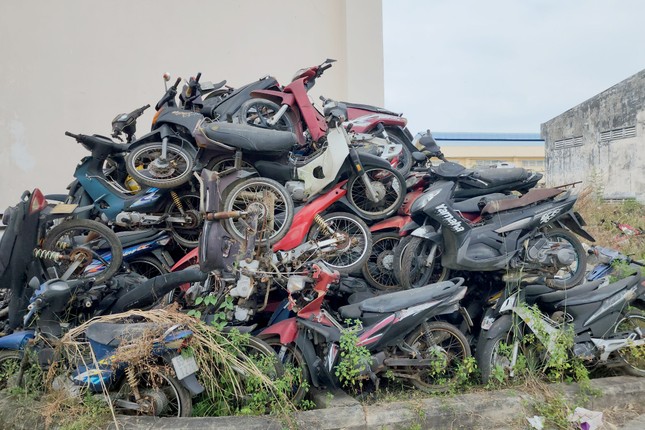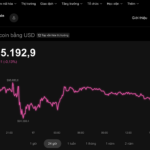A recent auction by a company offered 133 motorcycles and two-wheeled vehicles for sale as scrap. With a starting price of VND 97.1 million, this lot averaged a modest VND 730,000 per vehicle.
It is understood that any vehicles not meeting the re-registration criteria will have their frames cut and their chassis and engine numbers obliterated. Successful bidders must deface the chassis and engine numbers before removing the vehicles from the warehouse and are responsible for any associated costs.
These vehicles and items were confiscated by the District 5, Ho Chi Minh City, police and will be disposed of according to current regulations.

A pile of motorcycles at a temporary storage facility in Hoc Mon District. Source: Tien Phong
Auctioning off confiscated items has been practiced in many provinces and cities across the country. Most recently, in mid-July 2024, the police in Dong Da District, Hanoi, auctioned off a lot of 71 used two-wheeled motorcycles. These vehicles were ownerless and had been established as state-owned by the People’s Committee of Dong Da District.
Most of the 71 motorcycles still had license plates and were of various Honda and Yamaha models, including Dream and Sirius. Many of them no longer had identifiable chassis and engine numbers or production years.
A common denominator among these vehicles is that due to the lengthy process of confiscation, destruction, and auction of violation exhibits, they are all in a dilapidated and unusable state. The starting price for this lot was VND 42.3 million, averaging nearly VND 600,000 per vehicle.
Similarly, in Can Tho, the police in Phong Dien District are liquidating 118 motorcycles, 20 of which are roadworthy, while the rest are sold as scrap. The starting price for this lot is VND 96.9 million, excluding VAT.
Why Do Vehicle Owners Abandon Their Vehicles?
According to a report by Seasia Stats, in 2023, Vietnam had the highest rate of motorcycle usage in Southeast Asia. The motorcycle-to-population ratio in Vietnam reached 72.8%, surpassing Brunei (67.2%), Malaysia (45.2%), Indonesia (45.1%), and Thailand (30.6%).
Additionally, according to World Atlas, Vietnam ranks second globally in the percentage of households that own motorcycles (86%), second only to Thailand (87%).


A parking lot filled with confiscated vehicles in Hanoi. Source: Nguoi Lao Dong
Motorcycles have become a popular mode of transportation among Vietnamese due to their affordability and compact size, which makes them ideal for navigating through the country’s congested traffic and narrow alleys.
For many Vietnamese, motorcycles are not just a means of transportation but also a valuable asset. So, why would owners abandon these valuable possessions when they are confiscated?
According to Kinh tế và Đô thị, the primary reason for vehicle abandonment is a lack of proper registration documents, fake license plates, or the purchase of smuggled vehicles on the black market.
Additionally, some owners may have been involved in criminal activities, such as using stolen vehicles or possessing illegal substances while riding, and therefore do not dare to come forward to the police for verification.
Moreover, the fines for violations often exceed the actual value of the vehicles, and the process of reclaiming them is time-consuming, leading many owners to decide to abandon their confiscated vehicles.
According to Clause 4, Article 126 of the 2012 Law on Handling of Administrative Violations (as amended and supplemented in 2020) and Article 17 of Decree 138/2021/ND-CP on the management and preservation of exhibits and means of violation handling:
– In cases where the violator, owner, manager, or lawful user of the exhibit or means is identified, the person making the temporary seizure decision must notify them twice:
+ The first notification must be made within 3 working days from the date of expiry of the temporary seizure period of the exhibit or means. The second notification must be made within 7 working days from the date of the first notification.
+ If, after 1 month from the date of the second notification, the violator, owner, manager, or lawful user does not come to receive the exhibit or means, the competent authority must, within 5 working days, make a decision to confiscate the exhibit or means of administrative violation.
– In cases where the violator, owner, manager, or lawful user of the exhibit or means is not identified, the person making the temporary seizure decision must notify twice through the mass media of the central or local level where the exhibit or means is temporarily seized:
+ The first notification must be made within 3 working days from the date of expiry of the temporary seizure period of the exhibit or means. The second notification must be made within 7 working days from the date of the first notification.
+ If, after 1 year from the date of the second notification, the violator, owner, manager, or lawful user does not come to receive the exhibit or means, the competent authority must, within 5 working days, make a decision to confiscate the exhibit or means of administrative violation.















